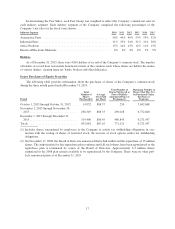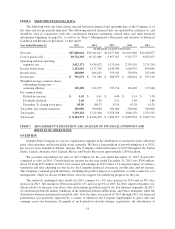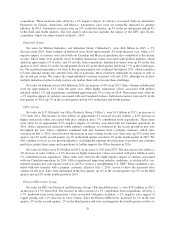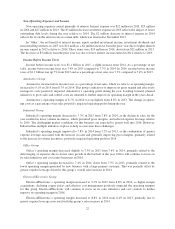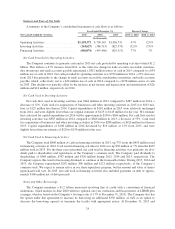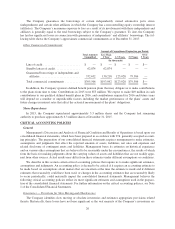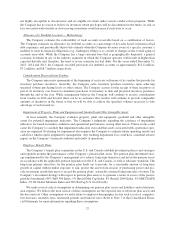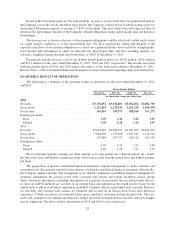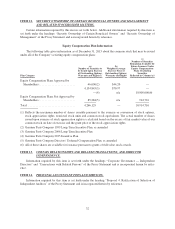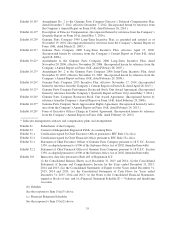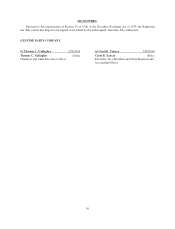Napa Auto Parts 2015 Annual Report Download - page 32
Download and view the complete annual report
Please find page 32 of the 2015 Napa Auto Parts annual report below. You can navigate through the pages in the report by either clicking on the pages listed below, or by using the keyword search tool below to find specific information within the annual report.
The Company guarantees the borrowings of certain independently owned automotive parts stores
(independents) and certain other affiliates in which the Company has a noncontrolling equity ownership interest
(affiliates). The Company’s maximum exposure to loss as a result of its involvement with these independents and
affiliates is generally equal to the total borrowings subject to the Company’s guarantee. To date, the Company
has had no significant losses in connection with guarantees of independents’ and affiliates’ borrowings. The fol-
lowing table shows the Company’s approximate commercial commitments as of December 31, 2015:
Other Commercial Commitments
Amount of Commitment Expiration per Period
Total Amounts
Committed
Less Than
1 Year 1-3 Years 3-5 Years
Over
5 Years
(In thousands)
Line of credit ......................... $ — $ — $ — $ — $—
Standby letters of credit ................. 62,874 62,874 — — —
Guaranteed borrowings of independents and
affiliates ........................... 332,632 130,218 123,028 79,386 —
Total commercial commitments .......... $395,506 $193,092 $123,028 $79,386 $—
In addition, the Company sponsors defined benefit pension plans that may obligate us to make contributions
to the plans from time to time. Contributions in 2015 were $55 million. We expect to make $49 million in cash
contributions to our qualified defined benefit plans in 2016, and contributions required for 2016 and future years
will depend on a number of unpredictable factors including the market performance of the plans’ assets and
future changes in interest rates that affect the actuarial measurement of the plans’ obligations.
Share Repurchases
In 2015, the Company repurchased approximately 3.3 million shares and the Company had remaining
authority to purchase approximately 6.3 million shares at December 31, 2015.
CRITICAL ACCOUNTING POLICIES
General
Management’s Discussion and Analysis of Financial Condition and Results of Operations is based upon our
consolidated financial statements, which have been prepared in accordance with U.S. generally accepted account-
ing principles. The preparation of our consolidated financial statements requires management to make estimates,
assumptions and judgments that affect the reported amounts of assets, liabilities, net sales and expenses and
related disclosure of contingent assets and liabilities. Management bases its estimates on historical experience
and on various other assumptions that are believed to be reasonable under the circumstances, the results of which
form the basis for making judgments about the carrying values of assets and liabilities that are not readily appa-
rent from other sources. Actual results may differ from these estimates under different assumptions or conditions.
We describe in this section certain critical accounting policies that require us to make significant estimates,
assumptions and judgments. An accounting policy is deemed to be critical if it requires an accounting estimate to
be made based on assumptions about matters that are uncertain at the time the estimate is made and if different
estimates that reasonably could have been used, or changes in the accounting estimates that are reasonably likely
to occur periodically, could materially impact the consolidated financial statements. Management believes the
following critical accounting policies reflect its most significant estimates and assumptions used in the prepara-
tion of the consolidated financial statements. For further information on the critical accounting policies, see Note
1 of the Consolidated Financial Statements.
Inventories — Provisions for Slow Moving and Obsolescence
The Company identifies slow moving or obsolete inventories and estimates appropriate provisions related
thereto. Historically, these losses have not been significant as the vast majority of the Company’s inventories are
26



